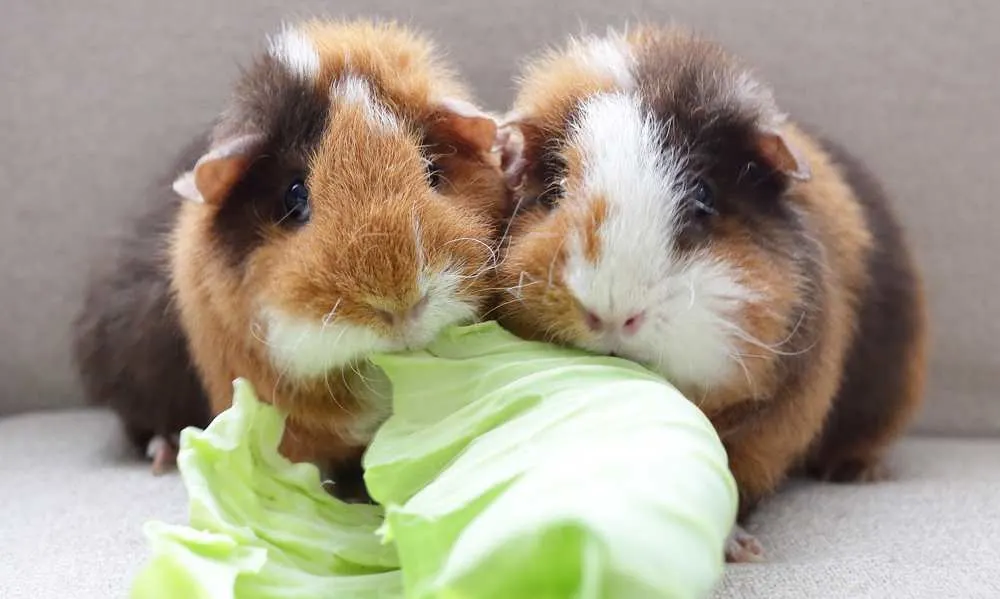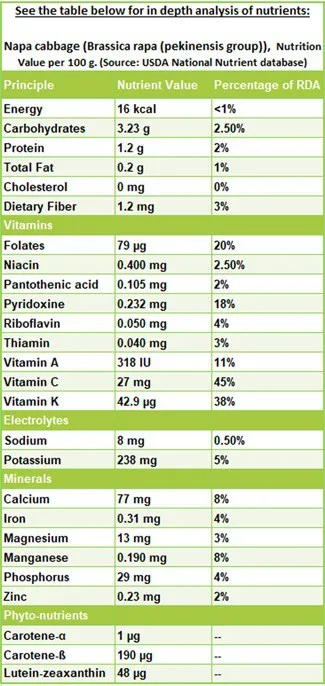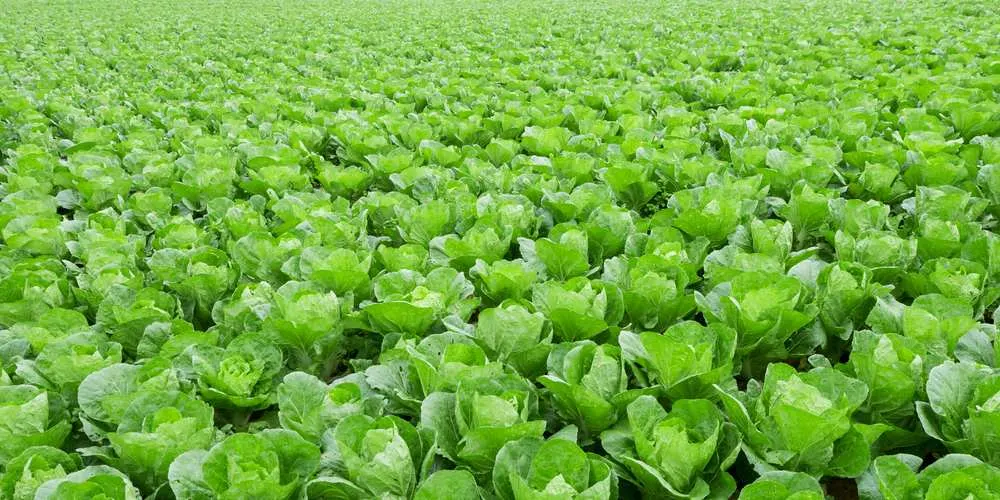Even though guinea pigs’ diet should be primarily based on timothy hay, it does not mean that you cannot include some veggies and fruit as well. Quite the opposite, the more varied the food your furry pet eats, the more valuable nutrients it will ingest and be healthier and happier.
The problem is that not all of the fruit and veggies are safe for your little piggy. It is generally better to feed more vegetables than fruit, too, since fruit has a high sugar content which is not good for guinea pigs.
So, now that we have determined that vegetables can enrich your pet’s diet, it would be only fair to cross at least one from the list and find out if it is safe for your piggy or not.
Today, we have picked a rather unusual veggie – Napa cabbage. We will answer the question: Can guinea pigs eat napa cabbage?
You do not have to worry if you have never eaten this veggie and have no idea what it is or what it looks like – we’ll tell you all you need to know about napa cabbage too. Just stick with us to the very end.
We are not as green as we are cabbage-looking – all our info comes from trusted sources, and we double-check every detail to make sure your pet is as safe and happy as it can be. Let’s start.

Can Guinea Pigs Eat Napa Cabbage? The Answer
Guinea pigs can safely enjoy most sorts of cabbages. Logically, different types of cabbage have different nutritional profiles, and some are better for your piggy than others.
So, can guinea pigs eat Chinese cabbage too?
Yes, Chinese cabbage is safe for guinea pigs, but there is a catch. Sadly, napa cabbage is one of the least appropriate types of cabbage for our furry friends.
Even though it contains a good amount of vitamin C your piggy so desperately needs to thrive, this sort of cabbage also has a high calcium content. As a result, guinea pigs can enjoy napa cabbage sparingly – only twice or three times a week.
You’ll understand it all better once you read about napa cabbage nutritional data, so stay tuned and learn more about this veggie.

Napa Cabbage Defined
Napa cabbage is a type of Chinese cabbage, and it is also known as celery cabbage or Chinese white cabbage. It is a cool-season annual vegetable that originated in the Yangtze River region in China.
This veggie belongs to the Brassica family. It has numerous relatives that all share some common traits, such as being leafy and having a flower-head. For example, the Brassica family includes regular cabbage, brussels sprouts, kale, and broccoli.
The first records of napa cabbage being cultivated come from the 15th century. It first traveled to Japan and Korea, but by the beginning of the 29th century, it conquered the world and is now consumed in all parts of it, including America.
What Are The Types Of Napa Cabbage?
There are two significant types of napa cabbage:
- Chilili – the heads of this type of napa cabbage are more cylindrical (about 18 inches long and six inches wide).
- Che for – this type of napa cabbage has more compact, round heads with white-petioled leaves.
How Does The Napa Cabbage Look?
Napa cabbage is egg-shaped and has dense, crinkled, pale green leaves. The leaves are crispy, which is why this type of cabbage is often called celery cabbage as well. An average napa cabbage weighs somewhere between one and three kilograms.
How Does The Napa Cabbage Taste?
Napa cabbage has a mild & sweet flavor. We would describe it as a combination of regular cabbage, celery, and iceberg lettuce.
How Can You Prepare And Eat Napa Cabbage?
Napa cabbage can be eaten both raw and cooked, which makes it highly versatile. You can pickle it too. This type of cabbage is often used in Asian dishes such as stir-fries, soups, pork wraps, Kim Chee, and gochujang.
Nutritional Data Of Napa Cabbage
Let’s start with an easy-to-follow table that says it all:

As you can see, napa cabbage is a low-calorie veggie with only 16 calories in 100 g of its fresh leaves. It does contain a hint of fat, though, so it should not be an all-you-can-eat type of food for an animal as tiny as a guinea pig.
Like all other types of cabbage, napa cabbage is packed with valuable vitamin C. It would be great news if only there were not as much calcium in this leafy vegetable too.
Why Is Calcium Bad For Guinea Pigs?
High levels of calcium in your guinea pig’s diet can endanger its health. It can lead to the formation of calcium and bladder stones, especially if there are high levels of oxalate acid as well.
Namely, this acid binds with calcium and forms stones that can be very painful for your pet. Thus, it would be best to make sure your piggy does not eat too much food that contains high levels of oxalate acid or calcium. Napa cabbage should be fed in moderation for this very reason too.
What Are The Health Benefits Of Napa Cabbage?
- It has super-high levels of vitamin C: As we have already discussed, napa cabbage is packed with precious vitamin C – it provides about 45% of its daily requirements. Just like humans, guinea pigs require vitamin C to stay healthy and develop properly.
- It is packed with many antioxidant plant compounds: Napa cabbage contains carotenoids, lutein, thiocyanates, zeaxanthin, sulforaphane, and other valuable antioxidants that protect the body from harmful free radicals.
- It is an overflowing source of soluble and insoluble dietary fiber: Dietary fibers help the digestive system but also offer protection from some types of cancer, such as breast or colon cancer. They also help in the reduction of “bad cholesterol” levels in the blood.
- It is an excellent source of folate: 100 g of fresh napa cabbage provides about 20% of the daily required levels of Folic acid. This B-complex vitamin is one of the fundamental components of DNA, and the lack of it can cause neurological diseases in newborn babies.
- It has reasonable levels of vitamin K: 100 g of napa cabbage provides about 38% of vitamin K RDA levels. This vitamin has an essential role in bone metabolism and helps delay osteoporosis. Vitamin K is also used for the treatment of Alzheimer’s disease since it has been proven to limit neuronal damage in the brain.
- It is a good source of many other essential vitamins: Napa cabbage is rich in riboflavin, pantothenic acid, and thiamin too. All of these vitamins help the body function properly and stay healthy.
- It is a source of electrolytes and minerals: Finally, napa cabbage is a good source of numerous minerals such as potassium, manganese, phosphorous, iron, magnesium, and the already-mentioned calcium. All of these minerals play essential roles in the human body, but calcium can cause issues in a tiny guinea pig’s body and should thus be limited.

Final Words
If you enjoy Asian cuisine and often have napa cabbage in your fridge, you can sometimes share it with your guinea pig. Most guinea pigs enjoy its mild taste and crispiness and will appreciate it. Besides, it is rich in vitamin C your piggy requires to stay healthy and develop properly.
Be careful, though! Do not overdo it – a leaf of napa cabbage twice a week will suffice!

